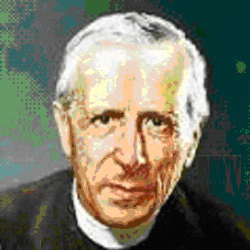 Once upon a time, a priest, in full clericals, was sitting in a train carriage, reading. A young university student entered the carriage and was excited to see that the priest was engrossed in a philosophy book. The young man said, “Father, I’m sorry to interrupt you but I see you are reading a treatise on Ontology. I, too, am studying philosophy and I have a brand new theory!” “Very interesting” said the priest, “do you want to tell me what it is?” “Oh yes” replied the student, “it all boils down to a single phrase: I am, therefore I think.” The priest stroked his chin thoughtfully and quipped, “Isn’t that putting Descartes before de horse?!”
Once upon a time, a priest, in full clericals, was sitting in a train carriage, reading. A young university student entered the carriage and was excited to see that the priest was engrossed in a philosophy book. The young man said, “Father, I’m sorry to interrupt you but I see you are reading a treatise on Ontology. I, too, am studying philosophy and I have a brand new theory!” “Very interesting” said the priest, “do you want to tell me what it is?” “Oh yes” replied the student, “it all boils down to a single phrase: I am, therefore I think.” The priest stroked his chin thoughtfully and quipped, “Isn’t that putting Descartes before de horse?!”
It gets even worse: Descartes once went into a pub and ordered a stiff whiskey. When he had finished it, the barman asked, “Would you like another?” Descartes replied, “I think not” – and promptly disappeared.
I can well imagine how Descartes came up with his famous statement, “Cogito, ergo sum” (I think, therefore I am). It was obviously his contribution to a debate that was going on in philosophy as to how we can actually know we exist. How would one prove to oneself, or to anybody else, that one is real? Descartes’ response was, “I know I exist because I can think.”
But suppose you were to write a novel and in this novel you created a debate between two of the characters in which one character asks the other, “How do you know you exist?” and the other replies, “I know that I exist because I can think!” Now is the character actually thinking or is he merely a projection of you, the author? Aren’t you simply putting words into his mouth, since the characters are, in fact, fictitious?
Or what about when you dream at night and you people your dreams with characters that have unique personalities and engage each other in dialog. They appear to be very real in the dream state. Suppose two of them engage in a philosophical debate in which one asks the other, “How do you know you exist?” and the other replies, “I know that I exist because I can think!” Now is this character actually thinking or is he merely a dream element, a nocturnal creation of yours?
I do not believe that thinking is incontrovertible proof of existence. Rocks exist but they do not think. Not everything that exists, thinks and not everything that thinks, exists.
God is not defined primarily by His ability to think but by Her ability to love.
How would you prove to yourself that you actually exist? I believe there is only one test. Something is real if it is a manifestation of God and God is not defined primarily by His ability to think, but by Her ability to love. Hence, the only evidence for existence is love.
You only exist to the extent that you love; but this is not a binary operation – you either exist or you don’t – rather it lies on a spectrum: you exist only to the extent that you love and you do not exist to the extent that you do not love. You’re real only if you love and you’re real only to the extent that you love.
What does not exist can have a huge effect on what does exist.
However non-existence does not mean that you can’t be detected or that you are not having an effect on your environment. Non-existence has huge effects. Let me try to explain that by working with a theory of the American astrophysicist Bernard Haisch, who speaks of, “Creation by subtraction.” He claims it is by limiting infinite possibilities that we create finite reality. Let me illustrate this with an analogy.
Imagine you are in a movie theatre that has a large screen up front and a small projectionist’s box up back, out of which a beam of pure white light is streaming onto the screen. Then the projectionist inserts a film and starts it in motion. The reason we see images is because the celluloid roll selectively occludes sections of the white light. We then mistake the absence of white light for the reality. So the missing white light is what we focus on, while the real white light is ignored. The images (what we take to be the reality) are simply the negation, obstruction and obfuscation of the light. So we’re fascinated and fixated on what is not there while ignoring what is there.
Love is the source and measure of all reality; everything else is simply a partially obstructed projection.
God is the white light and we put all kinds of obstructions in front of God, fail to see Him and, instead, worship the illusions of the multi-colored images on the screen of our perception. In this way, what does not exist can have a huge effect on what does exist. In this sense then, since only love is real, you exist only to the extent that you love. Either way you are having an effect.
Love is the source and measure of all reality; everything else is simply a partially obstructed projection. How real are you? You are only as real as your ability to love; as you block the light, you create suffering.
Love is not an attribute of God; rather “God” and “Love” are synonyms for ultimate reality. So, who are we really? We are droplets of love wrung from the heart of our Mother in the crucifixion of incarnation and the resurrection of enlightenment.
Wisdom, then, is the heart’s commitment to turn all experiences into love and ignorance is the ego’s addiction to turn all experiences into fear.
Wisdom, then, is the heart’s commitment to turn all experiences into love; and ignorance is the ego’s addiction to turn all experiences into fear. When love is turned inwards, it becomes Self-esteem and when love is turned outwards, it becomes compassion; when fear is turned inwards, it becomes depression and when fear is turned outwards, it becomes anger.
As I finished these musings, I looked outside my bedroom window and saw autumnal leaves floating unhurriedly to the ground and I heard myself ask God, “What is gravity?” He said, “Gravity is simply the name science uses for how I hug my star-children in a cosmic embrace.” “And what would you say about the future?” I asked. She replied, “The future belongs to the mysticists; those androgynous choreographers – part mystic, part scientist – who understand how the physical and the metaphysical universes dance to the symphony of Love.”












